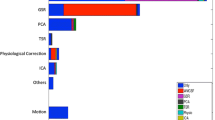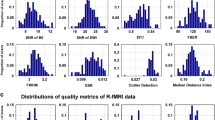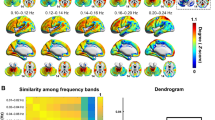Abstract
Recently, the retest reproducibility of intrinsic connectivity networks (ICNs) has become an increasing concern in the fMRI research community. However, few indexes can be applied to directly quantify the similarity of three or more ICNs for evaluating the retest reproducibility of ICNs. To solve this problem, a multivariable correlation coefficient based on zero-mean normalization and intraclass correlation coefficient (Z-ICC) is proposed. After demonstrating the calculation method and performance analysis on theory, Z-ICC is adopted to evaluate the similarity of three ICNs from three ICN sets, which are inferred from the open retest resting-state fMRI dataset NYU_TRT with dual temporal and spatial sparse representation (DTSSR). The reproducible ICNs and quantization index of retest reproducibility are obtained by the calculated Z-ICC values and the accepted evaluation criterion. The experimental results and visual inspection show that Z-ICC can effectively identify the reproducible ICNs and quantify the retest reproducibility of ICNs. Eighteen (Z-ICC > 0.8) of the inferred twenty ICNs with DTSSR that are found to be reproducible are far more than the seven reproducible ICNs based on temporal concatenation group ICA (TC-GICA). Furthermore, the result of the one-tailed two-sample T test demonstrates that the Z-ICC values of the reproducible ICNs by DTSSR are significantly greater than those of TC-GICA, indicating that more reproducible group-level ICNs with higher retest reproducibility can be achieved with DTSSR.









Similar content being viewed by others
Explore related subjects
Discover the latest articles, news and stories from top researchers in related subjects.References
Biswal B, Zerrin Yetkin F, Haughton VM, Hyde JS (1995) Functional connectivity in the motor cortex of resting human brain using echo-planar mri. Magn Reson Med 34(4):537–541
Smyser CD, Inder TE, Shimony JS, Hill JE, Degnan AJ, Snyder AZ, Neil JJ (2010) Longitudinal analysis of neural network development in preterm infants. Cereb Cortex 20(12):2852–2862
Beckmann CF, DeLuca M, Devlin JT, Smith SM (2005) Investigations into resting-state connectivity using independent component analysis. Proc R Soc B Biol Sci 360(1457):1001–1013
Guo CC, Kurth F, Zhou J, Mayer EA, Eickhoff SB, Kramer JH, Seeley WW (2012) One-year test–retest reliability of intrinsic connectivity network fMRI in older adults. Neuroimage 61(4):1471–1483
Biswal B, Mennes M, Zuo XN, Gohel S, Kelly C, Smith SM, Beckmann CF, Adelstein JS, Buckner RL, Colcombe S (2009) Toward discovery science of human brain function. Proc Natl Acad Sci USA 71(10):4734–4739
Smith SM, Fox PT, Miller KL, Glahn DC, Fox PM, Mackay CE, Filippini N, Watkins KE, Toro R, Laird AR (2009) Correspondence of the brain’s functional architecture during activation and rest. Proc Natl Acad Sci USA 106(31):13040–13045
Laird AR, Fox PM, Eickhoff SB, Turner JA, Ray KL, Mckay DR, Glahn DC, Beckmann CF, Smith SM, Fox PT (2011) Behavioral interpretations of intrinsic connectivity networks. J Cogn Neurosci 23(12):4022–4037
Kozák LR, Van LG, Chaudhary UJ, Szabó Á, Lemieux L (2017) ICN_Atlas: automated description and quantification of functional MRI activation patterns in the framework of intrinsic connectivity networks. Neuroimage 163(12):319–341
Adelstein JS, Zarrar S, Maarten M, Deyoung CG, Zuo XN, Clare K, Margulies DS, Aaron B, Gray JR, Xavier CF (2011) Personality is reflected in the brain’s intrinsic functional architecture. PLoS ONE 6(11):e27633
Kunisato Y, Okamoto Y, Okada G, Aoyama S, Nishiyama Y, Onoda K, Yamawaki S (2011) Personality traits and the amplitude of spontaneous low-frequency oscillations during resting state. Neurosci Lett 492(2):109–113
Zhu X, Wang X, Xiao J, Liao J, Zhong M, Wang W, Yao S (2012) Evidence of a dissociation pattern in resting-state default mode network connectivity in first-episode, treatment-naive major depression patients. Biol Psychiatry 71(7):611–617
Smitha KA, Arun KM, Rajesh PG, Thomas B, Kesavadas C (2017) Resting-state seed-based analysis: an alternative to task-based language fMRI and its laterality index. Am J Neuroradiol 38(6):1187–1192
Zhao T, Xu Y, He Y (2018) Graph theoretical modeling of baby brain networks. Neuroimage 185(15):711–727
Bullmore E, Sporns O (2009) Complex brain networks: graph theoretical analysis of structural and functional systems. Nat Rev Neurosci 10(3):186–198
Bi X, Zhao J, Xu Q, Sun Q, Wang Z (2018) Abnormal functional connectivity of resting state network detection based on linear ICA analysis in autism spectrum disorder. Front Physiol 9:475
Lv J, Jiang X, Li X, Zhu D, Chen H, Zhang T, Zhang S, Hu X, Han J, Huang H, Zhang J, Guo L, Liu T (2015) Sparse representation of whole-brain fMRI signals for identification of functional networks. Med Image Anal 20(1):112–134
Zhao S, Han J, Lv J, Jiang X, Hu X, Zhao Y, Ge B, Guo L, Liu T (2015) Supervised dictionary learning for inferring concurrent brain networks. IEEE Trans Med Imaging 34(10):2036–2045
Özmen G, Özşen S (2017) A new denoising method for fMRI based on weighted three-dimensional wavelet transform. Neural Comput and Appl 29(1):1–14
Yan X-D, Kelley S, Goldberg M (2012) Application of connected iterative scan in biological neural network. Neural Comput Appl 21(8):2097–2103
Wisner KM, Atluri G, Lim KO, Rd MA (2013) Neurometrics of intrinsic connectivity networks at rest using fMRI: retest reliability and cross-validation using a meta-level method. Neuroimage 76(8):236–251
Vetter NC, Steding J, Jurk S, Ripke S, Mennigen E, Smolka MN (2017) Reliability in adolescent fMRI within two years—a comparison of three tasks. Sci Rep 7(1):2287
Zuo XN, Kelly C, Adelstein JS, Klein DF, Castellanos FX, Milham MP (2010) Reliable intrinsic connectivity networks: test–retest evaluation using ICA and dual regression approach. Neuroimage 49(3):2163–2177
Wang JH, Zuo XN, Gohel S, Milham MP, Biswal BB, He Y (2011) Graph theoretical analysis of functional brain networks: test–retest evaluation on short- and long-term resting-state functional MRI data. PLoS ONE 6:e21976
Meindl T, Teipel S, Elmouden R, Mueller S, Koch W, Dietrich O, Coates U, Reiser M, Glaser C (2010) Test–retest reproducibility of the default-mode network in healthy individuals. Hum Brain Mapp 31(2):237–246
Fiecas M, Ombao H, Van LD, Baumgartner R, Coimbra A, Feng D (2013) Quantifying temporal correlations: a test–retest evaluation of functional connectivity in resting-state fMRI. Neuroimage 65(2):231–241
Wang N, Zeng W, Chen D, Yin J, Chen L (2016) A novel brain networks enhancement model (BNEM) for BOLD fMRI data analysis with highly spatial reproducibility. IEEE J Biomed Health 20(4):1107–1119
Wang J, Han J, Nguyen VT, Guo L, Guo CC (2017) Improving the test–retest reliability of resting state fMRI by removing the impact of sleep. Front Neurosci 11:249
Golestani AM, Kwinta JB, Khatamian YB, Chen JJ (2017) The effect of low-frequency physiological correction on the reproducibility and specificity of resting-state fMRI metrics: functional connectivity, ALFF, and ReHo. Front Neurosci 11:546
Chen X, Lu B, Yan CG (2017) Reproducibility of R-fMRI metrics on the impact of different strategies for multiple comparison correction and sample sizes. Hum Brain Mapp 39(1):300–318
Termenon M, Jaillard A, Delon-Martin C, Achard S (2016) Reliability of graph analysis of resting state fMRI using test–retest dataset from the Human Connectome Project. Neuroimage 142(11):172–187
Lin IK (1992) Assay validation using the concordance correlation coefficient. Biometrics 48(2):599–604
Gong J, Liu X, Liu T, Zhou J, Gang S, Tian J (2018) Dual temporal and spatial sparse representation for inferring group-wise brain networks from resting-state fMRI dataset. IEEE Trans Biomed Eng 65(5):1035–1048
Mairal J, Bach F, Ponce J, Sapiro G (2010) Online learning for matrix factorization and sparse coding. J Mach Learn Res 11:19–60
Shrout PE, Fleiss JL (1979) Intraclass correlations: uses in assessing rater reliability. Psychol Bull 86:420
Zuo XN, Martino AD, Kelly C, Shehzad ZE, Gee DG, Klein DF, Castellanos FX, Biswal BB, Milham MP (2010) The oscillating brain: complex and reliable. Neuroimage 49(2):1432–1445
Shehzad Z, Kelly AM, Reiss PT, Gee DG, Gotimer K, Uddin LQ, Lee SH, Margulies DS, Roy AK, Biswal BB (2009) The resting brain: unconstrained yet reliable. Cereb Cortex 19(10):2209–2229
Shutao L, Haitao Y, Leyuan F (2012) Group-sparse representation with dictionary learning for medical image denoising and fusion. Trans Biomed Eng 59(12):3450–3459
Yang X, Sun Q, Wang T (2018) No-reference image quality assessment based on sparse representation. Neural Comput Appl 9:1–16
Zhang H, Wang S, Xu X, Chow TWS, Wu QMJ (2018) Tree2Vector: learning a vectorial representation for tree-structured data. IEEE Trans Neural Netw Learn 29(11):5304–5318
Yang J, Liu Y (2017) Undersampled face recognition based on virtual samples and representation classification. Neural Comput Appl 1:1–7
Efron B, Hastie T, Johnstone I, Tibshirani R (2004) Least angle regression. Ann Stat 32:407–499
Zhang S, Li X, Lv J, Jiang X, Zhu D, Chen H, Zhang T, Guo L, Liu T (2013) Sparse representation of higher-order functional interaction patterns in task-based fMRI data. In: Medical image computing and computer-assisted intervention–MICCAI 2013. Springer, pp 626–634
Zuo XN, Xing XX (2014) Test–retest reliabilities of resting-state FMRI measurements in human brain functional connectomics: a systems neuroscience perspective. Neurosci Biobehav Rev 45:100–118
Han Z, Chen X, Yu Z, Shen D (2017) Test–retest reliability of “high-order” functional connectivity in young healthy adults. Front Neurosci 11:439
Landis JR, Koch GG (1977) The measurement of observer agreement for categorical data. Biometrics 33:159–174
Doria V, Beckmann CF, Arichi T, Merchant N, Groppo M, Turkheimer FE, Counsell SJ, Murgasova M, Aljabar P, Nunes RG (2010) Emergence of resting state networks in the preterm human brain. Proc Natl Acad Sci USA 107:20015–20020
Zhang W, Lv J, Li X, Zhu D, Jiang X, Zhang S, Zhao Y, Guo L, Ye J, Hu D (2018) Experimental comparisons of sparse dictionary learning and independent component analysis for brain network inference from fMRI data. IEEE Trans Biomed Eng 65:289–299
Acknowledgements
Financial support from National Natural Science Foundation of China (No. 61973108), Youth Foundation of Hunan Institute of Engineering (No. XJ1702) and National Natural Science Foundation of China (No. 81571341) is greatly appreciated.
Author information
Authors and Affiliations
Corresponding author
Additional information
Publisher's Note
Springer Nature remains neutral with regard to jurisdictional claims in published maps and institutional affiliations.
Rights and permissions
About this article
Cite this article
Gong, J., Liu, X., Sun, G. et al. Evaluating the retest reproducibility of intrinsic connectivity network using multivariate correlation coefficient. Neural Comput & Applic 32, 14623–14638 (2020). https://doi.org/10.1007/s00521-020-04816-8
Received:
Accepted:
Published:
Issue Date:
DOI: https://doi.org/10.1007/s00521-020-04816-8




